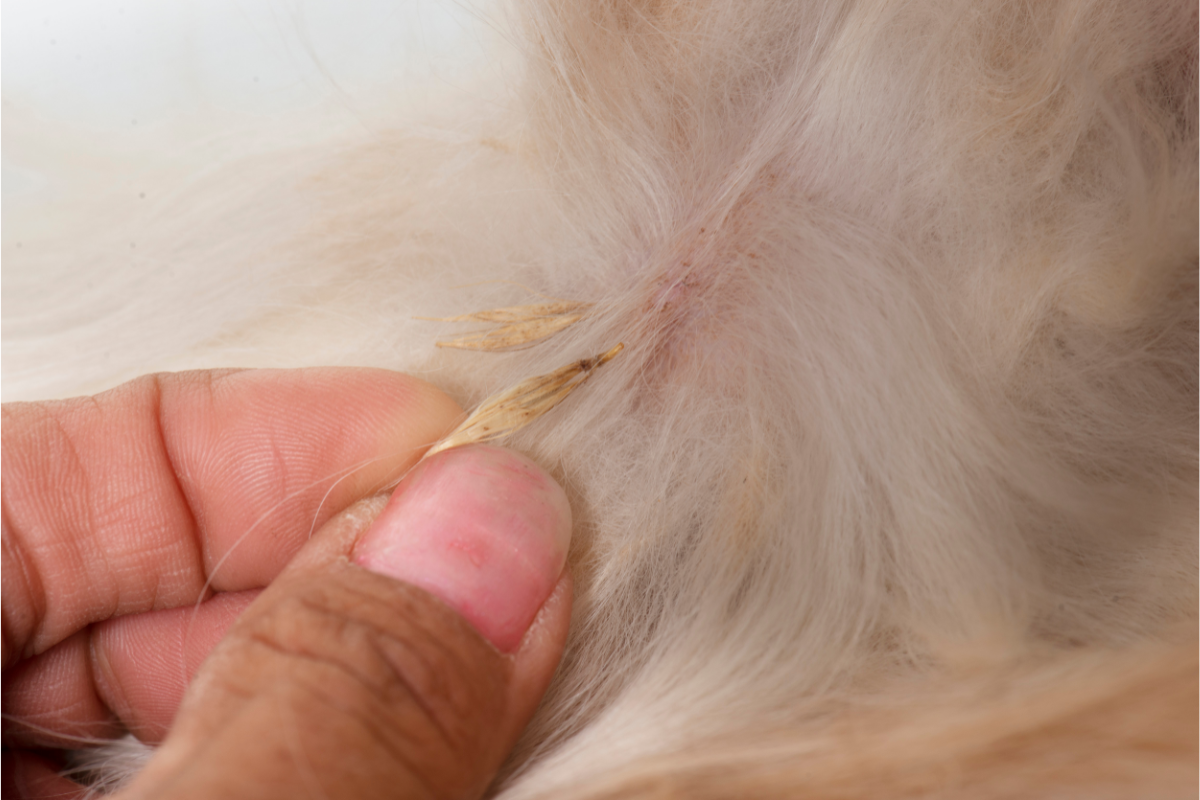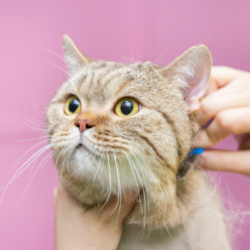Spikelets, the tiny seeds of grasses, can be a real danger to our four-legged friends. Often invisible and unobtrusive, they embed themselves in the coat and can lead to serious complications if not detected in time.
What are spikes?
Spikelets are dry spikes of grass, characteristic of plants in the Poaceae and Cyperaceae families. They are particularly dangerous for animals because of their structure, which makes it easier for them to cling to the coat. Once attached, the spikelets can penetrate the animal’s skin or body orifices, leading to serious complications.
The special feature of spikelets is their ability to cling to the clothes and hair of animals, particularly long-haired or curly dogs and cats. Spikelets are often invisible to the naked eye, making them difficult to detect. These tiny seeds can find their way into paw pads, ears, nostrils, eyes and even the genital or anal tract. Their pointed shape allows them to perforate the skin and progress inside the animal’s body.
The presence of spikelets is particularly high in spring and summer, when the grasses are fully mature. Spikelets can be found in fields, lawns and even gardens. Once attached to the animal, they begin their journey through the tissues, creating abscesses, fistulas and other serious lesions. It’s vital to be vigilant and to inspect your pet’s coat regularly, especially after a walk in the open air.
What are the signs of spikelet infiltration?
The symptoms of a spikelet infection may vary depending on where the spikelet is located in the animal’s body. It’s important to be alert to any unusual signs, as rapid intervention can prevent serious complications.
- Repeated sneezing: If the spikelet penetrates the nose, the animal may sneeze frequently, sometimes accompanied by nasal bleeding. These symptoms are alarming and require veterinary consultation.
- Eye problems: A spikelet in the eye can lead to a red or watery eye. The animal may blink, rub its eye or even keep its eye closed. These symptoms may indicate corneal ulceration, which requires immediate treatment.
- Head shaking: When a spikelet enters the ear, the animal may shake its head vigorously and scratch frequently. This can lead to inflammation of the ear canal, with a risk of perforation of the eardrum.
- Lameness and excessive licking: If the spikelet infiltrates the pads, it can cause visible lameness. The dog or cat may chew or lick the affected area excessively, where a small hole with serum effusion may be visible.
Take every symptom seriously, as spikelets can cause deep and lasting damage if not treated promptly. Consult a vet as soon as these signs appear.
How is the disease diagnosed?
Diagnosing the presence of a spikelet is often complex because of the small size of this foreign body and its ability to move inside the animal’s body. Only a vet can confirm the presence of a spikelet through a series of in-depth examinations.
During the clinical examination, the veterinarian first performs a meticulous auscultation of the animal. Depending on the symptoms and the presumed location of the spikelet, further tests may be necessary. Among the most common are :
- Ultrasound: This imaging test shows the presence of spikelets in soft tissue, particularly if the spikelet has already penetrated the skin.
- Endoscopy: Used mainly to examine the respiratory tract and ear canals, endoscopy makes it possible to locate and sometimes remove the spikelet without major surgery.
- Fibroscopy: Similar to endoscopy, this technique makes it possible to visualise internal cavities and identify the presence of spiracles in areas that are difficult to access, such as the bronchi or genital tract.
Depending on the location and depth of the spikelet, an X-ray may be necessary to detect any complications, although the spikelets themselves are rarely visible on standard imaging. Diagnosis must be accurate to avoid unnecessary interventions and ensure effective removal of the spikelet.
How do you get rid of a spikelet?
The main treatment is to remove the foreign body from the animal’s body. Depending on the location of the spikelet, the procedure can be more or less complex.
The veterinary surgeon uses foreign body forceps or an otoscope to extract the spikelet from accessible areas, such as the ear or eye. The procedure is performed under sedation to avoid any pain or stress for the animal. In some cases, he removes the spikelet without anaesthetic when the animal remains calm and the spikelet is easily accessible.
However, if the spikelet has become embedded in the skin or has begun to migrate inside the body, surgery may be required. The vet will then explore the affected area using foreign body forceps to locate and extract the spikelet. This can be a long and complex procedure, depending on the depth and location of the spikelet. If extraction is unsuccessful, several operations may be necessary, along with antibiotic and anti-inflammatory treatments to limit infection.
In extreme cases, where the spikelet has caused abscesses or fistulas, more invasive surgery may be required. The vet will have to open up the affected area, clean out the infected tissue and remove the spikelet. Post-operative follow-up is crucial to ensure the animal’s full recovery.
What are the natural alternatives?
If you suspect the presence of a spikelet, it is not advisable to try to extract it yourself. Unprofessional removal can leave fragments of the spikelet inside, leading to further complications. To temporarily relieve a dog suffering from a spikelet in the ear, it is sometimes suggested to pour a small amount of vegetable oil into the ear canal. This will soften the spike and reduce the pain until the dog is seen by a vet. However, this approach in no way replaces the intervention of a professional.
Natural remedies can include chamomile compresses to soothe minor eye inflammation or warm water baths to clean the paws after a walk. Specific essential oils can also be used, but only under the supervision of a vet, as some substances can be toxic to animals.
Finally, a veterinary examination is essential to ensure that the spikelet has been completely removed and that the animal has no internal lesions. Early and appropriate treatment is the key to avoiding serious complications.
What are the means of prevention?
Prevention is the best way to protect your pet from spider veins and the complications associated with them. A few simple measures can be taken to minimise the risks.
When out walking, it is advisable to keep your dog on a lead, especially in areas where grasses are present. This allows you to control where your dog moves and avoid high-risk areas. For dogs with long or curly hair, summer trimming can reduce the risk of spikelets getting caught. It is particularly important to trim the hair around the ears, between the pads and around the genital area.
After each walk, a thorough inspection of the coat is essential. Run your hands over the animal’s body to detect any spikes, paying particular attention to hidden areas such as the pads and ears. Regular brushing of the coat also helps prevent the build-up of spikelets and other plant debris.
If you have a garden, keep grass clippings and dispose of leftover clippings. Spikelets can be found not only in tall grass, but also in manicured lawns. By taking these precautions, you will considerably reduce the risk of your pet being affected by these small but formidable travellers.





